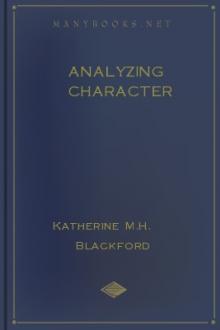Analyzing Character, Arthur Newcomb [popular romance novels .txt] 📗

- Author: Arthur Newcomb
- Performer: -
Book online «Analyzing Character, Arthur Newcomb [popular romance novels .txt] 📗». Author Arthur Newcomb
A more complicated advertisement followed this first one, giving the portraits of nine men, each successful in his chosen work because well fitted for it by natural aptitude as well as by training. People were asked to state the vocation of each. Out of 4,876 replies but three were correct.
SOME FUNDAMENTAL TRUTHS
Surely, when the untrained judgment of intelligent people goes so wide of the mark, it is worth while to inquire whether or not science can come to the rescue. Perhaps a brief examination of some well-established truths about human beings will aid in finding an answer to our query.
The science of character analysis by the observational method is based upon three very simple scientific truths:
First, man's body is the product of evolution through countless ages, and is what it is to-day as the result of the combined effect upon it of heredity and environment.
Second, man's mind is also the product of evolution through countless ages, and is what it is to-day as the result of the effect upon it of the same heredity and the same environment as have affected his body.
Third, man's body and man's mind profoundly affect each other in all of their actions and reactions and have affected each other through all the centuries of their simultaneous evolution.
EVOLUTION OF BLONDES AND BRUNETTES
Men's bodies differ from one another in many ways. A little scientific investigation soon proves to us that these differences are the result of differences in heredity and environment. Men's minds differ from one another in countless ways. Scientific investigation also proves that these mental differences, or differences in character, are also the result of differences in heredity and environment.
For example, people whose ancestors, through countless ages, lived in the bright sunlight and tropical luxuriance of the warmer climes, have dark eyes, dark hair, and dark skin because nature found it necessary to supply an abundance of pigmentation in order to protect the delicate tissues of the body from injury by the actinic rays of the sun. The same soft luxuriance of their environment has made these people slow, easy-going, hateful of change, introspective, philosophical and religious. On the other hand, people whose ancestors dwelt for centuries in the cold, dark, cloudy and foggy climate of Northwestern Europe have less need for pigmentation and are, therefore, flaxen-haired, blue-eyed and white-skinned.
The hardships and rigors of this Northern climate made these people aggressive, active, restless, fond of variety, and, because of their fierce struggle for existence, exceedingly practical, matter-of-fact, and material.
WHY NOSES DIFFER IN SIZE AND SHAPE
Another example illustrates this truth clearly: The type of human nose evolved in warm, humid climates is low and flat, with large, short passageways directly to the lungs. People living in such a climate have little need for great energy and activity, since there is food in abundance all around them. On the other hand, the type of nose evolved in a cold, dry climate is high in the bridge, with thin nostrils, so that the air may be both warmed and moistened before reaching the lungs. People living in such a climate have great need for activity, both in order to secure the means of subsistence and in order to keep themselves warm. Thus we find that the low, flat nose is everywhere the nose of indolence and passivity, while the large nose, high in the bridge, is everywhere an indication of energy and aggressiveness.
WHY SOME HEADS ARE HARD, OTHERS SOFT
In brief, then, darkness of color is not the cause of deliberation and conservatism, but both darkness of color and conservatism are results of the same causes, namely, a heredity and environment which produce these characteristics. Blonde coloring is not a cause of restless activity, but both the color and the activity are the result of evolution in a cold, dark, rigorous climate.
A striking example of the working out of the three truths which we have given is seen in the consistency of the body. Hard hands, hard muscles, and, in general, a dense, compact, unyielding consistency of fiber, are both inherited and acquired as the result of hard physical labor and the enduring of hardships. As is well known, those who spend their lives in grinding toil in the midst of hard conditions care little for the finer sentiments and sympathies of life. They have no time for them, no energy left for them. By the very necessities of their lot they are compelled to be hostile to change, free from all extravagance, and largely impervious to new ideas. Therefore, wherever we find hardness of consistency we find a tendency to narrowness, parsimony, conservatism, and lack of sympathy. Looking at this fact from a little different angle, we see that, since the body affects the mind and the mind the body so profoundly, the body of hard fiber, being impervious to physical impressions, will yield but slowly and meagerly to those molecular changes which naturally accompany emotional response and intellectual receptivity.
These are but a few examples of the truths upon which the science of character analysis by the observational method is based. Many others may occur to you. Many others have been observed, traced and verified in our work upon this science.
A BRIEF RECAPITULATION
Briefly recapitulating, we see that for every physical difference between men there is a corresponding mental difference, because both the physical differences and the mental differences are the result of the same heredity and environment. We see, further, that these physical and mental differences are not only results of the same environment affecting the individual through his remote ancestry, but that they are tied together by cause and effect in the individual as he stands to-day.
BASIS OF CLASSIFICATION
We have told you that the science of character analysis is classified knowledge. It is clear to you by this time that the knowledge which lies at the basis of this science is knowledge concerning physical and mental differences and their correspondences. In this science, therefore, since we are to observe physical differences and from them to determine differences in intellect, in disposition, in natural talents, in character in general, our first classification must deal with these physical differences.
Men differ from one another in nine fundamental ways These ways are: color, form, size, structure, texture, consistency, proportion, expression, and condition. Let us consider each of them briefly.
COLOR
Color is, perhaps, the most striking variable. You instantly observe whether a person is white or black, brown or yellow. Indeed, so striking are these variations that they were formerly the basis upon which humanity was divided into races.
We have already briefly touched upon the cause for pigmentation and the indications of differences in color. For many years anthropologists were at a loss to understand exactly why some men were black and others white. About twenty years ago, however, Von Schmaedel propounded the theory that pigmentation in the hair, eyes and skin was Nature's way of protecting the tissues from injury by the actinic or ultra-violet rays of the sun, which destroy protoplasm. Following the enunciation of Von Schmaedel's theory, prolonged experimentation was made by many anthropologists, chief among whom was our own late Major Charles E. Woodruff, of the U.S. Army. In Major Woodruff's book, "The Effects of Tropical Light Upon White Men," are to be found, set forth in a most fascinating way, evidences amounting almost to proof of the correctness of Von Schmaedel's theory.
Since Major Woodruff's book appeared, many other anthropologists have declared their acceptance of the theory, so that to-day we may assert with confidence that the black man is black because of the excessive sunlight of his environment, and that the white man is white because he and his ancestors did not need protection from the sun. Mountain climbers cover their faces and hands with a mixture of grease and lamp-black in order to prevent sunburn. When in India we wore actinic underwear, dark glasses, and solar topees to protect us from the excessive light.
DIFFERENCES BETWEEN BLONDES AND BRUNETTES
Now, in regard to differences in character between the dark races and the white races, you have only to consider the languorous air of the tropics and sub-tropics, the abundance of food, the small need for fuel, clothing and shelter—in general, everything in the environment which tends to make man indolent and to give him plenty of time for introspection, philosophy, theology, and the occult.
The dweller in Northern climes has had to wrestle with rapid changes, demands for food, clothing, shelter and fuel, relative scarcity of all these and difficulty of securing them—in short, nearly every possible element in his surroundings which would compel him to get out and hustle, to take an active interest in material things, to be constantly on the alert both mentally and physically—in a word, to master and conquer his environment.
These are some of the differences between the dark and the white races. We find the same differences in proportion between blondes and brunettes in the white races.
HAVELOCK ELLIS ON BLONDES AND BRUNETTES
The noted anthropologist Havelock Ellis says, in regard to this:
"It is clear that a high index of pigmentation, or an excess of fairness, prevails among the men of restless and ambitious temperament; the sanguine, energetic men; the men who easily dominate their fellows and who get on in life, and the men who recruit the aristocracy and who doubtless largely form the plutocracy. It is significant that the group of low-class men—artisans and peasants—and the men of religion, whose mission in life it is to preach resignation to a higher will, are both notably of dark complexion; while the men of action thus tend to be fair, men of thought, it seems to me, show some tendency to be dark."
The practical application of this truth is seen in the fact that the white races of the earth seem to have a genius for government, for conquest, for exploration, and for progress; while the dark races of the earth seem to have a genius for art, for literature, for religion, and for conservatism. Not long ago we read the conclusions of several anthropologists on this subject. One declared that the first men were undoubtedly brunette, and that the blonde was an abnormality and rapidly becoming extinct. Another was equally sure that the pure white blonde was a special creation but little lower than the angels, and that all the dark races were so colored by their sins. This is a matter upon which we hesitate to speculate. It would, however, be of some interest to know the respective coloring of these two investigators.
PRACTICAL APPLICATION OF LAW OF COLOR
Color has its commercial application. The active, restless, aggressive, variety-loving blonde is found in large proportions amongst speculators, promoters, organizers, advertising men, traveling salesmen; while the more stable and constant brunette predominates amongst the plodders, the planners, the scientists, the administrators, and the conservators. Even the poets bring out the difference. They sing of the fickle, light-hearted coquette with golden hair and azure eyes, and of the faithful, constant, true, undying affection of the lady with soft, brown eyes.
FORM
The second variable—Form—refers to form of face and features as seen in profile. The sharp face, with the long, pointed nose, prominent eyes, retreating forehead, prominent teeth and retreating chin, is the extreme convex form. The hammock-shaped face, with high, prominent forehead, flat brows, deep-set eyes, small snubbed or sway-back nose, retreating teeth and long, prominent chin, is the extreme concave in form of profile.
It would involve much dry, technical writing to explain in detail the scientific reasons why the extreme convex in profile indicates extreme energy, quickness, impatience, impulsiveness, keenness and alertness of intellect, and great rapidity in action. The large nose, high in the bridge, however,





Comments (0)